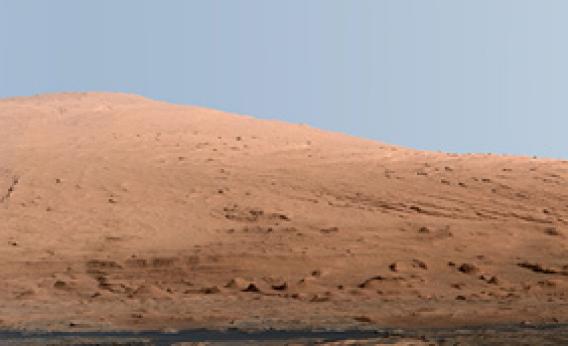Create a free profile to get unlimited access to exclusive videos, sweepstakes, and more!
Blue Skies Smiling at…Mars?

This is awesome and weird and cool and actually useful: A mosaic of Mount Sharpâthe five-kilometer (3-mile) high mountain in the center of Gale Craterâtaken by the Mars Curiosity rover has had its white balance altered to make the lighting conditions look as they would on Earth:
Mars with a blue sky is a bit disconcerting (hereâs a picture of a piece of Mount Sharp with the colors balanced correctly). But this is more than just a (ahem) curiosity. Geologists train under the lighting conditions we have here on Earth, but the Sun is fainter on Mars, and the sky a different, butterscotch color. That can trick the brain, making it harder to spot subtle details or see features that would be obvious here on Earth. So sometimes scientists fiddle with the pictures a bit to make them easier to analyze.
Iâve done this many times myself with Hubble images. There might be faint material surrounding a bright star, and itâs hard to see because the star is blasting away. Astronomers commonly change the contrast from a linear scaleâwhere something thatâs twice as bright is shown that wayâto a logarithmic scale, which goes by factors of ten. So an object 10 times as bright as another âin real lifeâ is scaled to only look twice as bright. A factor of 100 is displayed as a factor of three. Itâs actually more complicated than this, dealing with greyscales and such, but thatâs the idea.
It really helps in picking out faint sources in an image, and itâs probably because it mimics better the way our eyes see. Youâre sensitive to huge scales of brightness. The full Moon is the brightest object you can safely see in the sky (the next brightest is the Sun), and the full Moon is roughly 30 million times brighter than the faintest star you can see. Scaled logarithmically, thatâs only a factor of about 7.5. Much better.
And thatâs how your eyes work, more or less. If something twice as bright looked twice as bright to you, youâd hardly see any contrast at all. Our other senses are that way, actually. We use decibels for sounds, for example, and thatâs a log unit too.
Anyway, fiddling with images is a tried and true method to help scientists understand what weâre seeing. You have to be careful and not see something that isnât there, but getting trained to do that is easier than trying to see something you just canât see.
See?


























